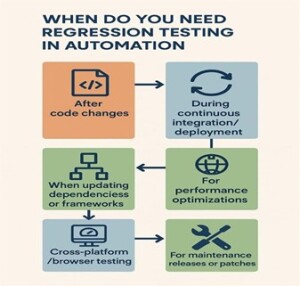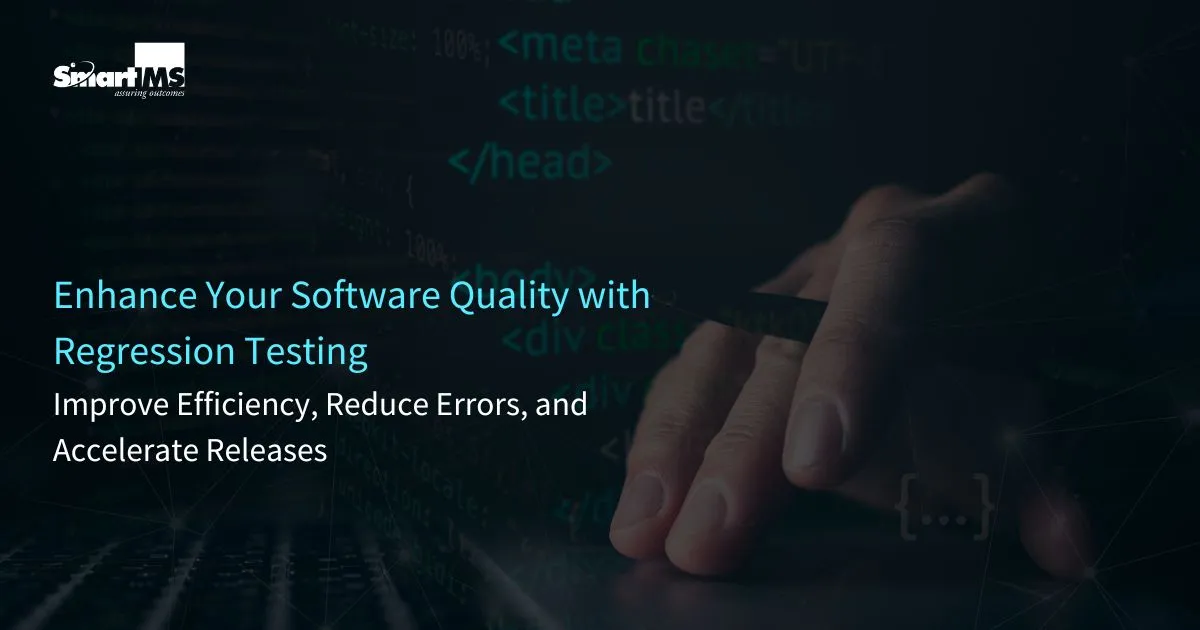In today’s fast-paced development environment, regression testing ensures that new updates don’t break existing features. When automated, it becomes faster, more reliable, and scalable making it a vital part of any modern QA process. It also provides quick feedback to developers, helping teams catch issues early and maintain product stability throughout continuous releases.
However, automation is not just about writing scripts and running them. Automation allows us to scale our testing efforts, catch bugs early, and accelerate delivery cycles without sacrificing quality. But automation alone isn’t enough, it needs to be done right.
At Smart IMS, we follow a robust set of best practices that help our QA teams design efficient, maintainable, and high-impact regression test suites. These practices not only reduce manual effort but also ensure that our testing efforts are aligned with both technical and business objectives.
Let’s get started with the different types of regression testing in software testing.
Types of Regression Testing in Software Testing
Regression testing ensures that recent code changes haven’t adversely affected the existing functionality of a software application. Here are the main types of regression testing used in software testing:
- Unit Regression Testing
- Scope: Performed during the unit testing phase.
- Focus: Tests individual units or components in isolation.
- Goal: Ensure the function/module still works as expected after a change.
- Partial Regression Testing
- Scope: Performed when changes are made to a part of the system.
- Focus: Verifies that the code works correctly with the unchanged parts of the application.
- Goal: Ensure new code integrates well with existing code.
- Complete Regression Testing
- Scope: A full system test is conducted.
- Focus: All test cases are re-executed.
- Goal: Validate that the entire system still functions correctly after major changes.
- Corrective Regression Testing
- Scope: Applied when there are no changes in the existing code.
- Focus: Re-runs existing test cases.
- Goal: Confirm that unchanged code still works and previously fixed bugs haven’t resurfaced.
- Progressive Regression Testing
- Scope: Done when requirements change and new test cases are written.
- Focus: Ensure that the new test cases don’t affect the existing functionalities.
- Goal: Maintain the integrity of old and new functionalities together.
- Selective Regression Testing
- Scope: Runs only a subset of test cases.
- Focus: Based on the impact analysis, tests only the affected areas.
- Goal: Save time while still validating critical parts.
Now, let’s take a look at,
When Do You Need Regression Testing?

Regression testing is essential in several scenarios to ensure the stability and functionality of your application:
- After Bug Fixes: Whenever bugs are fixed, regression testing ensures that the fix doesn’t unintentionally affect other parts of the application.
- During Continuous Integration & Development: As part of CI/CD processes, regression testing validates that new code changes do not introduce issues into previously working features.
- To Enhance Performance: When optimizing or refactoring code, regression testing ensures performance improvements don’t compromise other aspects of the system.
- When Updating Dependencies: Changes in third-party libraries or frameworks can impact your application. Regression testing ensures compatibility and proper functionality post-update.
- In Cross-Platform & Browser Testing: Ensures the application behaves consistently across different platforms, operating systems, and browsers.
- To Maintain Stability in Released Versions: Post-release, regression testing guarantees that updates or patches don’t disrupt the stability or user experience of the application.
Now, let’s understand the challenges of the same.
Challenges in Regression Testing:
Regression testing automation offers numerous benefits but also presents several challenges that must be addressed for optimal results.
- Test Maintenance & Flaky Tests: As applications evolve, test maintenance becomes critical. Regular updates are necessary to prevent flaky tests, ensuring consistent results over time.
- High Initial Setup Costs: The initial investment in automation can be significant. However, a scalable and modular framework can help reduce long-term costs and improve efficiency as the system grows.
- Execution Time: As test suites expand, execution times tend to increase. Leveraging parallel execution and cloud-based tools can mitigate delays and accelerate test execution.
- Test Coverage Gaps: Automated tests may leave gaps in test coverage. A balanced approach that combines automated and manual testing ensures comprehensive validation and reduces the risk of overlooking critical areas.
- Dynamic Elements & Advanced Strategies: Dynamic elements in applications require advanced wait strategies and robust selectors. Ensuring these elements are correctly handled is essential for reliable test outcomes.
- Environment & Test Data Stability: Consistent test environments and reliable test data are crucial for accurate testing. Tools like Docker offer stability by replicating environments across different machines.
- CI/CD Integration: Integrating automated tests into CI/CD pipelines can be complex. However, prioritizing tests based on critical paths and scheduling them effectively can minimize disruption and streamline the testing process.
Now, let’s take a look at the best practices that can help mitigate the above challenges.
10 Best Practices for Regression Testing
- Maintain a Stable Regression Suite
Only include tests that consistently pass and provide reliable results. Unstable tests (flaky tests) can create noise and reduce confidence in the test suite.
- Keep the Test Suite Clean and Updated
As your application evolves, your tests must evolve too. Regularly update or remove outdated tests to reflect current functionality and prevent false positives or negatives.
- Prioritize Test Cases
Focus on testing critical business features, recently changed areas, and historically defect-prone components. This helps catch major issues faster and optimize testing time.
- Use the Right Automation Tools
Choose tools that match your project needs (e.g., tech stack, team skills, environment). Good tools save time, integrate well, and provide useful insights into failures.
- Integrate with CI/CD Pipelines
Automatically trigger tests with each code change using tools like Jenkins, GitHub Actions, or GitLab CI. This catches bugs early and supports continuous delivery.
- Modular and Reusable Test Scripts
Write reusable and maintainable test code using patterns that minimize duplication and make the test suite easier to manage.
- Optimize Test Execution Time
Speed up testing by running tests in parallel and categorizing them (e.g., smoke, sanity, full regression). This ensures faster feedback without sacrificing coverage.
- Comprehensive Reporting and Logging
Use test reports with detailed logs, screenshots, and step-by-step traces. This helps teams quickly understand and fix issues when tests fail.
- Review and Analyze Failures Promptly
Investigate test failures as soon as they happen. Determine whether they’re due to real bugs, environmental issues, or test script errors, and take corrective action.
- Monitor Test Coverage
Track how much of your code is being tested. Use coverage tools to identify gaps in test coverage and improve test quality and completeness.
As we understood the best practices, let’s give a read about the different tools used for Regression Testing.
Types of Tools used for Regression:
- Tricentis Tosca – Model-based automation tool for enterprise-scale regression testing.
- Selenium – Automates browser-based testing across different browsers and platforms.
- Appium – Enables cross-platform mobile app testing for Android and iOS.
- Cypress – Fast, developer-friendly tool for modern web application testing.
- Jenkins – Automates regression test execution through continuous integration.
- Postman (with Newman) – Automates REST API testing within CI/CD pipelines.
- TestNG – Organizes and runs structured, scalable automated tests.
- BrowserStack – Cloud-based platform for cross-browser and device testing.
- Katalon Studio – All-in-one platform for web, API, and mobile test automation.
- SoapUI / ReadyAPI – Industry-standard tool for automated API testing.
- UFT One (Unified Functional Testing) – A commercial tool for functional and regression testing of desktop, web, and enterprise applications, supporting a wide range of technologies.
Final Thoughts:
At Smart IMS, we ensure the reliability and stability of every release by following best practices in regression testing. We automate our testing process, focusing on maintaining modular and reusable test suites to improve efficiency and reduce manual effort.
By prioritizing critical functionalities and continuously monitoring issues, we can quickly identify regressions and ensure consistent performance. This approach helps us deliver high-quality, scalable solutions that evolve while maintaining core functionality and reliability.
Ready to ensure the stability of your releases?
Contact us today to learn more about how our regression testing solutions can streamline your development process.




